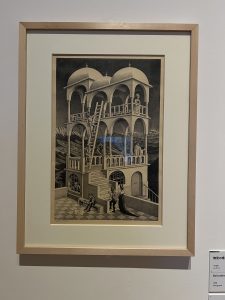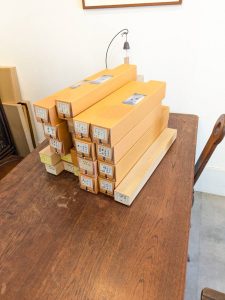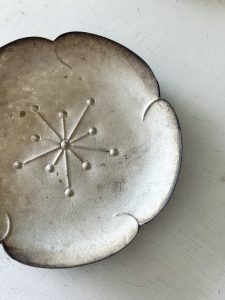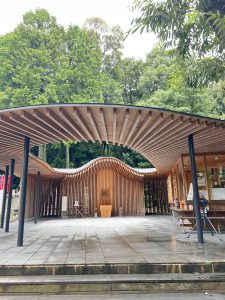皆さまこんにちは、スタッフYでございます。
先日、豊田市美術館にて開催されております「エッシャー展」行って参りました。詳細は後ほどお伝えするといたしまして、早速いってみましょう。

エッシャーといえば数々のだまし絵が有名ですよね。かつての美術の教科書などで見たことを思い出して、あぁ!と思い出す方もいらしゃるのではないでしょうか。そんな彼の技法やデザインもそうなのですが、木版画そのものの精巧さの進化にも驚かされる展覧会でありました。

球体の中には彼の姿が
エッシャーについて少しご説明いたしますと、
正式名は、 マウリッツ・コルネリス・エッシャー。1898‒1972年オランダ生まれでありまして、みる人に驚きと発見を与え数学者やアーティストから子どもたちにまで世界的に人気の高い版画家であります。
ある形で平面をくまなく覆い尽くす「テセレーション(敷き詰め)」、一つの形が次第に別の形へと変形する「メタモルフォーゼ(変容)」など、人間の視覚や錯覚を利用した緻密で幾何学的な画風が特徴的でして、今回の展示は、オランダのエッシャー財団の全面的協力のもと、初期のイタリアの風景から「だまし絵」的な代表作まで約160点を一堂に展示。かつてどこかで見たことのあるだまし絵も多数展示されておりました。
写真撮影可能ということで、お写真多めでご紹介いたしましょう。
まずお気づきかと思いますが、これらはすべて木版画という手法で表現されていることに驚かされます。エッシャーはその生涯に400点以上の作品を残しているのですがすべてが版画であり、驚くことに水彩画や油彩画はありません。
版画というジャンルにこだわり続け、あらゆる技法に精通し使いこなしたこと、そして納得のいくものができるまで妥協しない姿勢と粘り強さ、それらを考えても、エッシャーの在り方はひとつの分野に専心する「職人」に近いのでしょうか。近くで鑑賞しますとその精巧さと様々なチャレンジに引き込まれていきます。

「蔵書票」
およそ10センチ四方ほどの作品でしたが、線の表現が異次元ですね。(うまく表現ができませんが笑)

「物見の塔」 1958年 リトグラフ
ご存じの方もおいででは。一見普通の建物に見えますが、しばらく見ておりますと柱や階段があれあれ?どうなっているんだ…。と、解決のつかぬまま見続けてしまいます。

「相対性」 1953年 リトグラフ
こちらも。もはや自分が立っているのか、わからなくなります。

「バベルの塔」 1928年 木版
そして、そんな彼のもう一つの試みが、ある形で平面をくまなく覆い尽くす「テセレーション(敷き詰め)」、一つの形が次第に別の形へと変形する「メタモルフォーゼ(変容)」。こちらはテセレーションを表現した作品の拡大した展示物。

「太陽と月」 1948年 木版(こちらは、拡大した展示)
エッシャーにとって重要な意味を持っている経験がスペインのアルハンブラ宮殿訪問でして、彼は二回アルハンブラ宮殿を訪れております。
教義によって偶像が禁止されているイスラム教では、動物や人間のイメージの代わりに抽象的な文様が発展してあおり、そのアルハンブラの壁を飾る幾何学文様もそのひとつ。その緻密な計算に基づいた「無限に続くパターンがつくり出す美」にエッシャーに強い感銘を受け、それは「太陽と月」のような「テセレーション(敷き詰め)」を表現した作品として生まれていきます。
そして、もう一つの表現「メタモルフォーゼ(変容)」の代表作。

メタモルフォーゼⅡ 1939-40年
それにしても、エッシャーの画歴を見渡してると、「粘り強さ」「試行」「精巧」などなど作品のすばらしさの他にたくさんの言葉が浮んできますし、どの年代の作品もチャレンジが尽きない。
また、共に版画という技法を何故選んだのか、そこも気になってきます。原画から版板、紙へと転写する過程で変化・進化しうるし、また版板や紙の状態や木目などがもたらす影響も予測できない手のかかる版画の技法を選んだことも、彼にとってはまた一つのチャレンジだったのでしょうか。
実際に、エッシャーは自分のことを「芸術家」ではなく「版画家」と考えていたようで、この事からも、エッシャーの「版画」に対する誇りと思いや彼自身そうありたいと願っていたであろう姿が伝わってきますね。
色々な作品を鑑賞しましたが、実に興味の尽きない展覧会でした。
それにしても、デジタル社会を生きる私たちが今の時代とは真っ向違うアナログな版画という手法で想像力豊かなエッシャーの作品を観ていますと、作品のから伝わる迫力も相まってでしょうか、現在のデジタルをも超越しているような錯覚を自分は感じました。敵わないな…。
百聞は一見に如かず。
是非足を運んで、エッシャーの世界にふれてみてください。
ご一読ありがとうございました。
それでは、ごきげんよう。
企画展「エッシャー 不思議のヒミツ」
会期:2024年7月13日(土)〜9月23日(月・祝)
会場:豊田市美術館 展示室6・7・8
住所:愛知県豊田市小坂本町8-5-1
開館時間:10:00〜17:30(入場は17:00まで)
Hello everyone, this is Staff Y.
The other day, I visited the “Escher Exhibition” at the Toyota Municipal Museum of Art. I will tell you the details later, but let’s get started.
Escher is famous for his numerous trompe l’oeil paintings. Some of you may remember seeing his works in your art textbooks in the past! You may remember his techniques and designs. The exhibition was a surprise not only for his techniques and designs, but also for the evolution of the sophistication of the woodblock prints themselves.
Let me explain a little about Escher,
Maurits Cornelis Escher, born in the Netherlands between 1898 and 1972, is a printmaker who is popular worldwide among mathematicians, artists, and children alike for his ability to inspire wonder and discovery.
His works are characterized by a precise and geometric style that makes use of human vision and optical illusions, such as “tessellations,” in which one shape covers an entire flat surface, and “metamorphoses,” in which one shape gradually transforms into another. This exhibition, with the full cooperation of the Escher Foundation in the Netherlands, brings together approximately 160 works, ranging from early Italian landscapes to representative “trompe l’oeil” style paintings. Many trompe l’oeil paintings that we have seen somewhere before were also on display.
Since photography was allowed, I will introduce them here with many photos.
First of all, as you may have noticed, you may be surprised to know that all of these works are expressed by the technique of woodblock prints. In his lifetime, Escher left more than 400 works, all of which are prints, and surprisingly, none of them are watercolors or oil paintings.
Considering his persistence in the genre of printmaking, his mastery and mastery of all techniques, and his uncompromising attitude and tenacity until he was satisfied with his work, it would seem that Escher was more like a “craftsman” dedicated to a single field. When viewed up close, the exquisiteness of his work and the various challenges he undertakes will draw you in.
Some of you may know this tower. At first glance, it looks like an ordinary building, but after looking at it for a while, you may wonder what is going on with the pillars and stairs. What is going on? You will keep looking at it without finding a solution.
This one, too. I no longer know whether I am standing or not.
Another of his attempts is “tessellation,” in which a certain shape covers the entire plane, and “metamorphosis,” in which one shape gradually transforms into another. This is an enlarged version of a tessellation work.
An experience of great significance to Escher was his visit to the Alhambra Palace in Spain, which he visited twice.
In Islam, where idols are forbidden by doctrine, abstract patterns have developed in place of animal and human images, including the geometric patterns that adorn the walls of the Alhambra. The geometric patterns that adorn the walls of the Alhambra are one such example. Escher was strongly impressed by the “beauty created by endless patterns” based on precise calculations, and these patterns were born as works expressing “tessellations” (paving) such as the “sun and moon”.
Looking over the history of Escher’s art, words such as “tenacity,” “trial,” and “elaborate” come to mind in addition to the wonder of his works, and there is no end to the challenges in his works from any age.
I am also curious as to why both artists chose printmaking as their medium of choice. Was it a challenge for him to choose printmaking, which is a difficult and unpredictable technique that can change and evolve in the process of transferring the original to plate and paper, as well as the effects of the condition of the plate and paper and the grain of the wood?
In fact, it seems that Escher considered himself a “printmaker” rather than an “artist,” which shows his pride and passion for “printmaking” and his wish to be one.
I saw a variety of works and found the exhibition to be very interesting.
However, as we live in a digital society, looking at Escher’s richly imaginative works using analog printmaking, a technique that is completely different from the current era, I felt the illusion of transcending the current digital world, perhaps due in part to the power of the works themselves. I felt as if the works transcended even today’s digital technology, which is something I cannot compete with.
Seeing is believing. I highly recommend you to see the exhibition in person. Thank you for reading.
Have a good day.
Special Exhibition “Escher: The Secret of Wonder
Dates: July 13, 2024 (Sat) – September 23, 2024 (Mon)
Venue: Toyota Municipal Museum of Art, Exhibition Room 6, 7, 8
Address: 8-5-1 Kosakamoto-cho, Toyota City, Aichi Prefecture
Hours: 10:00 – 17:30 (Admission until 17:00)
*******************
ご実家の整理やお片付けなどをされている方のご相談などが多くございます。
お片付けなどくれぐれもご無理のないようになさってくださいませ。
風光舎では古美術品や骨董品の他にも絵画や宝石、趣味のお品など様々なジャンルのものを買受しております。
お片付けをされていて、こういうものでもいいのかしらと迷われているものでも、どうぞお気軽にご相談下さいませ。
また風光舎は、出張買取も強化しております。ご近所はもちろん、愛知県内、岐阜県、三重県その他の県へも出張いたします。
まずは、お電話お待ちしております。
愛知県名古屋市千種区姫池通
骨董 買取【古美術 風光舎 名古屋店】
TEL052(734)8444
10:00-18:00 OPEN
#出張買取#骨董#古美術#骨董品#絵画#版画#茶道具#刀剣#彫刻
























